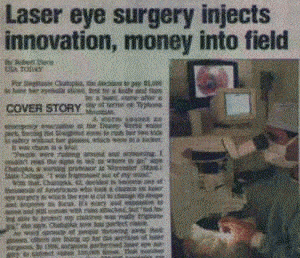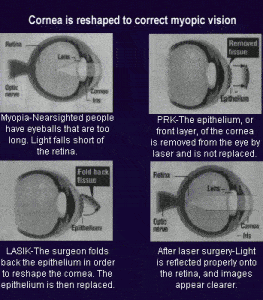
For Stephanie Chalupka, the decision to pay $5000 to have her eyeballs sliced, first by knife and then by a laser, came after a day of terror on Typhoon Mountain. A storm caused an emergency evacuation at the Disney World water park, forcing the ill-sighted mom to rush her two kids to safety without her glasses, which were in a locker. It was chaos in a blur.
“People were rushing around and screaming. I couldn’t read the signs to tell us where to go,” says Chalupka, a nursing professor at Worcester (Mass.) State College. “I was frightened out of my mind.” With that, Chalupka, 42, decided to become one of thousands of Americans who took a chance on laser eye surgery in which the eye is cut to change its shape and improve its focus. It’s scary and expensive to some and still comes with risks attached, but “not being able to protect my children was really frightening,” she says. Chalupka now has perfect vision.

As word spreads of people throwing away their glasses, others are lining up for the services of laser surgeons. In 1996, surgeons performed laser eye surgery to correct vision 100,000 times. That number doubled last year and another 350,000 surgeries are expected this year. If last week’s Federal Trade Commission price fixing action against laser manufacturers holds, the cost may begin to come down for the first time. But experts warn that risk of permanent damage should be weighed and that people should pick only the most experienced surgeons.
“Don’t be a guinea pig,” warns Irving Arons of Spectrum Consulting, who has studied the trends in laser eye surgery for 15 years. While more than 200,000 people in the USA have had laser eye surgery, millions more could benefit. More that 63 million people in the USA are nearsighted, the the condition laser surgery helps the most. The technique has also been used to help those with other vision problems, including astigmatism-distortion from a misshapen eye-and farsightedness. The business potential has put a new glimmer in the eyes of doctors. ” It’s transformed ophthalmology from the world of medicine to the world of business,” says Arun Lakra, an ophthalmologist and co-author of the book, In Search of 20/20: Everything you need to know about laser eye surgery.“From a dollars standpoint, it’s injecting new blood and money into a field that had been a little dormant.”

Michael Lachman, an analyst for the investment banking firm Hambrect & Quist, says laser eye surgery will be a $1 billion industry by 2000. “You have all these people saying it’s the best $4,000 or $5,000 they’ve ever spent,” he says. “It’s hard to find people that aren’t ecstatic about it.” The idea for this kind of surgery dates to the late 1800s. That’s when a European ophthalmologist envisioned improving an eye’s focus by cutting the eyeball with a knife to change its shape. Japanese doctors developed a technique that worked in the 1940’s. It was first performed in the USA in 1978. But computers and lasers made the task much more successful in the 1990’s.
And this area of surgery is evolving quickly. A new version is gaining momentum before governmental approval. The basic laser surgery, which is approved by the Food and Drug Administration, is photorefractive keratotomy or PRK. It involves the surgeon removing micro-thin layers of the cornea with a laser. When the layers are removed from the cornea-the very front of the eye which protects the lens through which we see-light is focused on the retinal, making vision clear. To shave the layers from the cornea, surgeons use one of two excimer lasers approved by the FDA to deliver bursts of ultraviolet light. The laser can vaporize precisely targeted corneal tissue with better precision that a surgeon using a knife. The procedure takes about 15 minutes and the eye heals with the aid of medicated drops within a few months. But surgeons have developed a new procedure that is based on PRK but which backers say has advantages. In laser in situ keratomileusis, or LASIK, a surgeon cuts a flap of the cornea on the front of the eye with a knife-like instrument, peels the flap to one side and performs the PRK with the laser. The flap is then replaced as natural bandage. Benefits include less pain, clearer vision faster after surgery and fewer infections.
The big risk: a flub while cutting the flap is devastating. “You’re actually cutting into the eye with a blade instead of zapping the superficial surface,” Lakra says. “It’s a more surgeon-dependent procedure. It raises the question of how you select your surgeon.” LASIK has not yet been approved by the FDA, but it has gained favor among skilled surgeon and their patients. Analysts say LASIK may be approved this year. The FDA regulates drugs and medical devices but does not control how doctors practice medicine. So a doctor can perform the procedure before it has been fully studied in clinical trials as long as the patient is told of the known risks. FDA approval would mean doctors could advertise the procedure.

But word of the surgery has spread quickly without advertising. On the scene just three years, LASIK will account for more than 65% of laser eye surgeries in the USA this year and more than 70% of those worldwide, according to Arons’ own survey of surgeons. Most experienced laser eye surgeons are switching to LASIK. Nearly 70% of the procedures performed by the busiest laser eye surgeons last year were LASIK cases, compared to 47% the year before, the survey found. LASIK is also more expensive, about $2,500 per eye compared to $1,500 for PRK. Because both procedures are considered cosmetic, neither is covered by insurance. “With all of the things that are not covered by insurance, I don’t think that this should be covered,” says Chalupka. “It’s cosmetic. I like the way I look without glasses.”
Not everyone is so pleased with the results. Steve Samuels, a 34-year old psychology professor at the Air Force Academy in Colorado Springs, Colorado, warns others not to rush into the decision. He’s been struggling with poor night vision and halos around bright lights-typical side effects that usually clear up within a few months-ever since he had his eyes done in early March. “I woke up the next morning and I couldn’t read,” he says. “Nobody told me that was going to happen.” There are no public figures from government on LASIK yet, but doctors say its side effects seem less problematic than those for PRK. The PRK studies found:
- 5% of patients still needed glasses for distance; 15% for situations like driving.
- Many patients saw haze, glare or halos around lights for up to six months after surgery. As the eye tissue that’s been cut heals, these effects almost always disappear.
- 5% of patients had slightly worse vision after surgery.
- As people age, they may still need reading glasses.
- Long-term risks are unknown. Nobody knows if there are problems that might arise 10 to 20 years after surgery.
Samuels says he had trouble getting facts before his surgery. “I wish I had pushed them more,” he says. “I would have liked to see more numbers.” “You can get caught up in the sales,” Samuels says. “I’d say don’t rush your doctor. It’s surgery. There’s a knife, there’s a laser and they’re your eyes.” The industry agrees, urging patients to ponder the risks carefully before reaching a decision. Both the FDA and the Federal Trade Commission have monitored advertising for unsubstantiated claims that might mislead the consumer. The FDA says some patients have been permanently injured, including cases of blindness that required corneal transplants. Last week, the FTC voted to charge the two companies that sell the government-approved lasers with price-fixing. If successful, that action could cut the price of seeing more clearly by $100 to $250 per eye. The FTC estimates consumers were over-charged about $30 million last year because of the arrangement between VISX of Santa Clara, California and Summit Technology of Waltham, Massachusetts. At the same time, other doctors are offering even newer procedures that also change the shape of eyes. In one, a ring inserted into the eye would change the shape of the eye much the way the laser surgery does, casting the light onto the retina to generate a crisp image. In the other, an internal lens would correct the vision the way a contact lens does when placed atop the eye, but the internal lens would be permanent. “Joe consumer out there is a confused puppy right now,” Lakra says. “They’ve heard stories, but they’re reluctant to have anything done.” He encourages patients to look for the most qualified doctor and not expect a miracle.
Ernest Kornmehl, medical director at the Kornmehl Laser Eye Associates in Boston who operated on Chalupka agrees. “The best patient is the educated patient,” he says. “We only do the procedure on people with very realistic expectations. Patients who look at it as throwing away their glasses will be disappointed.”